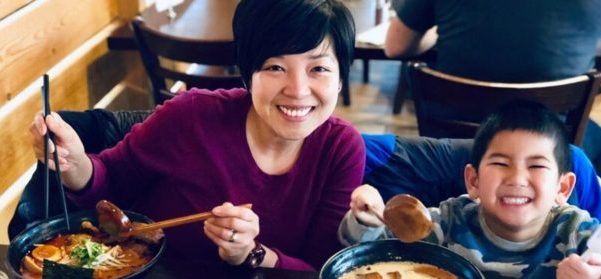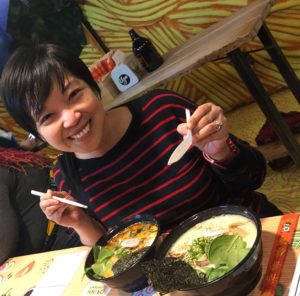I’m a noodle fan. Being Filipino, it’s practically genetic. When my son was little, he was really into food court lo mein, which is similar to Filipino pancit canton. It’s basically egg noodles, stir-fried with veggies and meat, sometimes with a savory, brown sauce. My son prefers thicker noodles, and our local food court’s lo mein was his absolute favorite. At that time, he was still learning how to eat by himself. He was getting pretty good with using a spoon in his right hand, but he would get frustrated with the slippery noodles, because a spoon wasn’t really the ideal tool. I would cut up the noodles and then show him how to use the fork with his other hand to get the noodles onto his spoon.
As researchers, many of us are a bit like my son. We’re usually trained to use one set of tools, either quantitative or qualitative, but rarely both. And we tend to apply the same tools we know over and over, even when other tools are called for. Often, in our research, we keep trying to eat lo mein with a spoon and it just keeps falling off.
Different types of noodle dishes require different approaches to eating them. If I was eating a dry noodle dish like pancit bihon, a fork might do just fine. On the other hand, if I was eating pancit molo, a dumpling soup with short-cut noodles, then a spoon would work better. But if I’m eating soupy, long noodles – like batchoy, mami, or sotanghon – then this calls for mixed methods. A fork and a spoon. Or chopsticks and a spoon. Or just chopsticks and then you sip the soup directly from the bowl. Whether or not it is appropriate to slurp soup directly from the bowl depends on the “context.” For example, would people around you consider slurping rude, and does that matter to you? Then there’s the question of sequencing. Soup first, then noodles? Or the reverse? How about alternating soup and noodles? Or my personal favorite, a little bit of both in every bite? One can certainly combine methods, and everyone probably has their preferred eating “style”, but you can’t just use one utensil or approach. You need one way to eat the noodles, and another way to eat the soup. Soupy (long) noodle dishes are just a bit more complicated.
In research, like in noodle-eating, complexity requires new ways of doing things. And what could be more complex than measuring empowerment? This, in a nutshell, is exactly what we’re trying to do in the Gender, Agriculture, and Assets Project, Phase 2 (GAAP2), supported by the Bill & Melinda Gates Foundation, USAID, and the CGIAR Research Program on Agriculture for Nutrition and Health. GAAP2 is working with a diverse set of 13 agricultural development projects to develop and test a project-level measure of women’s empowerment. Our goal is to develop a tool that allows us to compare how well different types of projects are empowering women. Which strategies are working best? We also want this tool to be flexible and allow users to be able to drill-down and unpack trends, understand how behavior is changing, and gather more detailed information on topics they care more about, like health and nutrition, livestock, or market inclusion. This would help projects figure out how to maximize their impact and design better interventions.
Designing this tool, the Women’s Empowerment in Agriculture Index for projects, or pro-WEAI, is a big, complicated task, definitely putting us in soupy-noodle territory. All 13 projects in the GAAP2 portfolio have the explicit goal of empowering women, not just reaching or benefiting them. But their interventions, strategies, and activities vary. Some work with crops, livestock, or both. Apart from empowering women, they may have other goals like improving nutritional status or increasing household incomes. These projects are located in different types of communities, across nine countries in Africa and South Asia. Each setting can be as unique as one of the many versions of soupy noodle dishes. This is why we need mixed methods to understand what works, what doesn’t work, and how we can make it better.

In the draft pro-WEAI, recently piloted by the participating projects, we use both quantitative and qualitative methods to measure three types of agency: intrinsic agency (power within), instrumental agency (power to), and collective agency (power with). While the 12 pilot pro-WEAI indicators and overall index are computed using survey data, we relied on qualitative research to assess how well our theoretical notions of agency matched up against what women and men themselves described as empowering or disempowering. From our qualitative work, we found that local communities echoed Naila Kabeer’s definition of empowerment, using terms like: “having economic means” and “connections” (resources), being “active” and “taking care of one’s self/family/others” (agency), and being “well-dressed” and “admired” (achievements). One key insight that we drew from these findings was that an empowered woman is someone who can take care not only of herself but of others. Empowerment is not just about the woman; it goes beyond her. This strengthens the need for expanding indicators around collective agency in pro-WEAI.
Up next, participating projects are completing their qualitative data collection and getting ready to use pro-WEAI in their endline surveys to look at their impact on women’s empowerment and other outcomes. We’re also working with colleagues from Emory University to make sure we’re measuring each type of agency correctly, using psychometric methods to validate pro-WEAI.
As we dig into this slippery, complex concept called women’s empowerment, we’re refining our technique and testing different ways to measure it. We may not have all the answers yet, but we’re getting there, one bite (or slurp) at a time.
Hazel Malapit is a Senior Research Coordinator at the Poverty, Health and Nutrition Division at the International Food Policy Research Institute (IFPRI). She coordinates research, training and technical assistance on the implementation of the Women’s Empowerment in Agriculture Index (WEAI), manages and coordinates the integration of gender into the research of the CGIAR Research Program on Agriculture for Nutrition and Health (A4NH), and conducts research on gender, women’s empowerment, agriculture, health and nutrition issues. Before joining IFPRI, she held the Herman Postdoctoral Fellowship in Gender and Economics at the University of Michigan, Ann Arbor in 2009-2010, and conducted research on gender, labor market and data issues at the World Bank’s Gender and Development unit (PRMGE). She received her MA in Economics from the University of the Philippines, and her PhD in Economics from American University.
Cultural Practice partners with IFPRI on the GAAP2 pro-WEAI qualitative studies.
Photos courtesy of Hazel Malapit

